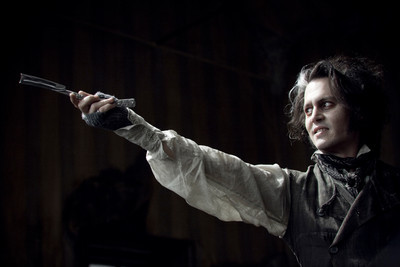“Sweeney Todd: The Demon Barber of Fleet Street”

There’s thrilling — as in “producing sudden, strong and deep emotion or excitement.” And there’s thrilling — as in enrapturing, “moving with rapture; delighting beyond measure.”
Beyond that, there’s “Sweeney Todd: The Demon Barber of Fleet Street,” which is both.
True confession time: The first time I saw “Sweeney Todd,” in June 1980 on Broadway, I was convinced it was the greatest musical I had ever seen.
Nothing I’ve seen in the more than quarter-century since has changed my opinion one iota. Including the new movie version of composer Stephen Sondheim’s masterwork.
Granted, “Sweeney” is just one of many classics from the audacious imagination of Broadway’s reigning music man.
But it’s been Sondheim’s misfortune (and ours) that his stage peak, in the 1970s and ’80s, coincided with the virtual disappearance of the movie musical.
Yet, wonder of wonders, a big-screen musical revival seems to be in full swing, making the time more than ripe for “Sweeney.” Especially as the occasion for director Tim Burton and actor Johnny Depp’s sixth, and arguably greatest, collaboration.
When it comes to musicals, the otherworldly, otherweirdly Burton-Depp team doesn’t immediately spring to mind. But “Sweeney Todd” is hardly your typical gotta-sing, gotta-dance romp.
Consider the title character: a horribly wronged Victorian barber (Depp) who returns to London after years in exile, only to discover his wife gone forever and his daughter a virtual prisoner of the same lecherous judge (Alan Rickman, all sly self-righteous menace) who falsely imprisoned him.
Sweeney vows vengeance — by shaving “the faces of gentlemen who never thereafter were heard from again,” as Sondheim relates in “The Ballad of Sweeney Todd,” which dominates the stage original but is nowhere to be heard (or seen) onscreen.
That excision is typical of “Sweeney’s” canny stage-to-screen transition.
In the theater, especially in its original incarnation, “Sweeney” loomed very large, its gigantic factory set and teeming, keening chorus conjuring the bleak 19th-century London of Charles Dickens — and Jack the Ripper.
Yet onscreen, Burton and Co. render the massive Broadway production on a more intimate, more human scale, focusing almost exclusively on Sweeney and his desperate plan for revenge.
Aiding that bloody quest: Sweeney’s friend and landlady, Mrs. Nellie Lovett (Helena Bonham Carter), a widow (in)famous for baking “The Worst Pies in London.” That is, until a secret ingredient, supplied by Sweeney, transforms Mrs. Lovett’s meat pies into a taste sensation.
Despite its gruesome subject matter, “Sweeney Todd” delves even further into the mysteries of the human heart.
Sure, our hero’s a serial killer, his partner in crime helping dispose of his victims in meat pies that transform her eager customers into unwitting cannibals. Yet Sweeney and Mrs. Lovett also confront such issues as lost love, shattered families — and how easily innocent souls can become caught and crushed in the meat-grinder of life.
Serious stuff, to be sure, giving “Sweeney Todd” an emotional gravity many musicals lack.
Because the movie also puts us up close and personal with its tormented title character’s pain, it also (perhaps inevitably) cuts into “Sweeney Todd’s” macabre comedic moments, which registered more strongly onstage. (One notable exception: the delicious sequence when the title character challenges a pompous street-fair charlatan, played in typically uproarious fashion by “Borat’s” Sacha Baron Cohen, to a shaving duel.)
Those who never have met “Sweeney Todd” won’t miss the black comedy amidst all the blood. Those of us who do know him, and the show, shouldn’t mind — because the movie soars so strikingly on its own terms.
In streamlining the narrative, screenwriter John Logan and Sondheim trim the score without sacrificing its forceful beauty. They understand that what merits a three-minute song onstage can be conveyed in half the time, with twice the impact, onscreen.
Especially with Burton’s trademark imagination running riot, conjuring visual equivalents for Sondheim’s dazzling lyrics at every turn — especially as his camera dances amid a stark, dark world devoid of light and color. (Except, of course, when the blood spurts forth — or when Sweeney remembers his wife and daughter, back when life was bright and blooming.)
Such contrast between Sweeney’s forever vanished past and the heartbreaking present offers a haunting counterpoint to Sondheim’s towering score.
Onstage, that score sometimes approaches the level of opera in its range, complexity and power.
And while no one would cast Depp or Carter in a Broadway production of “Sweeney Todd,” their very vocal limitations work perfectly in the more personal medium of the movies.
Sondheim always says he prefers actors who sing rather than singers who act, opting for performers able to convey the characters’ emotions and carry the story. Even if that means sacrificing a few musical nuances in the process.
Both Depp and Carter invest their bedeviled characters with such depth of feeling that it hardly matters when they’re not quite up to the music. (That happens more often with Carter than with Depp.)
Downplaying the almost cartoonish lunacy the legendary Angela Lansbury brought to her Tony-winning stage portrayal of Mrs. Lovett, Carter expertly captures her cheerfully amoral practicality, along with her poignant romantic yearning. She’s a woman who does what she must, even if it breaks her heart in the process.
Sweeney’s heart, by contrast, has long since ceased to function, as his misfortune has transformed him from man to monster. Depp not only finds the victim within the monster, he explores a remarkable range of emotions within Sweeney’s demented, agonized soul. Yes, he’s a monster without a heart — but that doesn’t mean our hearts can’t break for him all the same.
Contact movie critic Carol Cling at ccling@reviewjournal.com or (702) 383-0272.